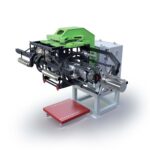British supercar marque McLaren has revealed a limited-edition variant of its new 675LT. Dubbed the MSO Carbon Series LT, the car was brought to life by McLaren Special Operations (MSO) and is cloaked almost completely in high-gloss carbon-fibre. Based on the 675LT Spider, MSO’s special has had an additional 40 per cent of its bodywork replaced with the high-strength lightweight material. The A-pillars, front and rear wings, bonnet, retractable roof and side blades have all received the carbon-fibre treatment. Even the fuel-filler cap hasn’t been ignored. The additional carbon-fibre components join the front bumper, front splitter, side intakes, rear arches, rear bumper, diffuser and ‘longtail’ air brake which were already made of the stuff. Aside from the obvious tweaks, the Carbon Series LT is largely unchanged from the ‘standard’ 675LT. Power is still delivered by a 3.8-litre twin-turbo V8 developing 496kW/700Nm, and the car’s 2.9-second sprint to 100km/h remains the same. Small changes to the powertrain include more efficient turbos, an upgraded fuel pump and delivery system along with tweaks to the cylinder heads, exhaust manifolds, camshaft and connecting rods. According to the exotic car maker, it built the rare vehicle after its customers were excited by the carbon-fibre-bodied McLaren P1 that was showcased at the Geneva motor show. McLaren Special Operations is planning a very limited run of just 25 Carbon Series LTs, with all of them already spoken for. Customers waiting for delivery of the normal 675LT should note, the extra work that has gone into producing the Carbon Series LT prevents the carbon-fibre components being retrofitted to the normal car. Production of the unique Carbon Series LT will begin in the coming months, with deliveries expected by the end of 2016.















